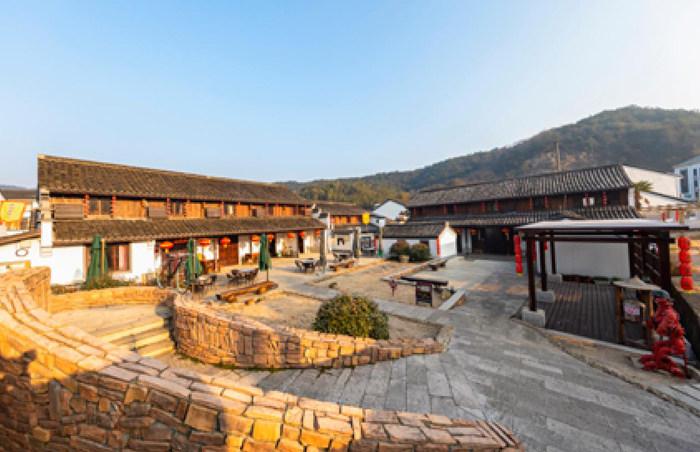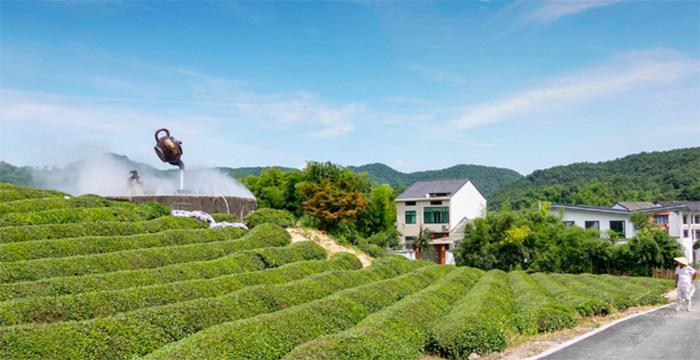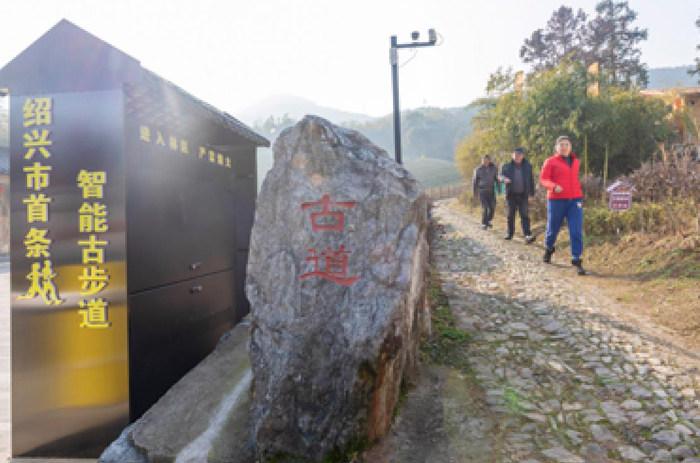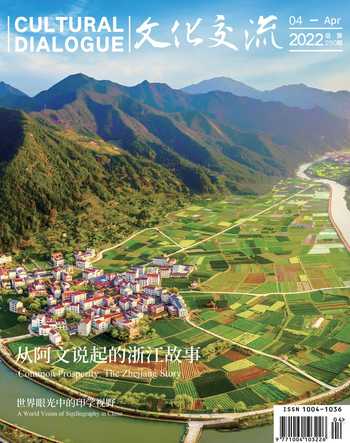艺术改变乡村
窦瀚洋 方彭依梦



这里依傍会稽山脉,三面环山;这里是远近闻名的艺术村、网红村、富裕村。这就是浙江省绍兴市越城区坡塘村云松自然村。只要您一进村口,就会听到村民演唱的带有浓厚绍兴特色的曲艺“莲花落”,配合着满山茶田,给这个小村庄平添了几分宁静祥和。就在几年前,这里还是绍兴有名的“上访村”,村民矛盾突出,经济发展滞后,村容村貌脏乱差,违法建筑随处可见,有人还称呼这里为“破塘村”。
是艺术改变了这个村。在中国人民大学艺术学院“艺乡建”团队的帮助下,坡塘村云松自然村刮起“艺术风”。创作创意作品、建设展示平台、设计微型景观、开发产品……村民共同参与,村庄变得更美,带动增收,真正让艺术改变了乡村。
家住坡塘村云松自然村的陈荣苗怎么也没想到,自己做了大半辈子的竹制品如今竟成了艺术品,还能用来开店赚钱。
“村里毛竹多,这些竹制品都是就地取材。”在工艺品店铺里,不时有游客进进出出,陈荣苗热情地介绍着琳琅满目的竹制工艺品。他说,这样的改变还要从艺术团队的到来说起。
艺术团队让村民耳目一新
2020年初,来自中国人民大学艺术学院的“艺乡建”团队来到云松村采风调研、开展作品设计。村里人不懂:艺术团队为啥要来我们村?
一进村,“艺乡建”领队陈炯就出了个主意。“陈教授让我们动员村民,把绸布挂到茶园上方。”坡塘村干部罗国海回忆道:“大家难免有疑惑,挂几块布能有啥效果?”
直到去年,村里的百亩茶园飘起了柠檬色的绸布,一件名为《看见风》的艺术作品就此诞生,还被不少媒体报道,许多游客慕名而来,打卡网红景点。
“随后的几个月里,1万多人陆续来到云松村。”罗国海说:“没想到我们这个小村庄也能这么热闹。”这次,云松村村民感受到了“艺术的力量”。
“后来,艺术团队又在村里挨家挨户收集‘有故事’的布料,大家这次就很配合,我还从女儿出生的襁褓上剪了一块。”这块布见证了陈荣苗一家的变化,也让他成为创作团队的一员。最终,大家将云松村每家最有意义的布料缝制在一起,形成了一件别致的公共艺术作品《百家布》,全村人都是创作者。
罗国海说,大家从新鲜到感动,从疑惑不解到积极参与,那段时间,艺术团队成员和村民同吃同住,大家建立起深厚的情谊。
山水之美融合生活之乐
向村落深处走去,云上乡村艺术馆、云上舞台、云上直播间等艺术展示平台在沿途自然衔接,将山水之美与生活之乐融合起来。
沿着陈家岭古道迈上茶园观光台,百亩茶园映入眼帘,这里是云松村的标志性景观。极目远望,一把直径约两米的茶壶悬空倒挂,壶嘴喷射出一道水柱,在蓝天和茶山映衬下,化为烟雾散在空中。
罗国海说,这是去年7月村委會自主打造的微景观,取名“云壶飞瀑”,现在已成为村里新的打卡点。在他看来,艺术之所以能在云松村从无到有并“开花结果”,是因为大伙儿都变“文艺”了。
这其中,就包括陈伟国、潘林娥夫妇。艺术团队进村前,夫妻俩主要经营运输,“听说有人来村里带着我们一起搞艺术,一开始挺不理解的。”陈伟国说。
茶园那件《看见风》的艺术作品,村里拉上陈伟国一起参与。后来团队又给他们支招,让他们试着在短视频平台记录云松村的生活日常,并建议他们摆起糍粑小摊。“上次就有个小姑娘特意跑来买糍粑,说是我们短视频平台上的粉丝。”陈伟国说:“过去的想法太片面。”
村里还开始主动尝试“微改造、精提升”,将水管上色做成竹节形状,通过手绘美化井盖,破旧水表箱成了象棋盘……罗国海介绍,类似创意还有很多,“只要带着一双发现美的眼睛,其实村里很多地方都能变成景观。”
村貌古朴清新又文艺
如今,漫步村中,老物件装饰的景观小品、独具创意的墙面设计、老台门里的咖啡馆、村屋改造的书屋……云松村里一步一景。陈荣苗的工艺品小店也在其中。去年9月,村里特意打造了这个店铺,村民有手工艺品都可以放在这里售卖。有了小店,陈荣苗的观念也渐渐改变——以前缺啥做啥,现在竹艺制品不再局限于生产生活需求,迷你版的竹水桶、竹扁担、竹制水车作为产品,也受到游客喜爱。
“前段时间还有游客打电话来,让我做一套竹制酒杯。”这给陈荣苗带来新的灵感,也带来新的收入。自从开店以来,靠着售卖竹艺制品,他已增收5000余元。
沈菊英也实现了在家门口赚钱的心愿。“我原来在城里打工,看到老家越来越好就回来了。”沈菊英的家就在茶山脚下,位置非常好,罗国海鼓励她开餐馆。“会有人来吃饭吗?”带着迟疑,去年10月,她的餐厅成了云松村第一家农家乐。
“有个外地姑娘来吃饭,说是特意来打卡的,我才知道还有这个新词。”50多岁的沈菊英正努力尝试新花样,“摆盘、包装都要讲究,我们还专门为店员定制了民俗服装。”沈菊英说:“村干部让我们结合云松村的历史文化研究几样特色菜,可以给游客讲讲云松村的故事。去年中秋、国庆,平均每天营收三四千元,一天要备20多桌菜。”
如今的云松村,古朴清新又文艺,成为观光、团建的好去处。“艺术赋能乡村振兴,2021年坡塘村集体经济收入165万元,实现高增长。截至目前,村里依靠新兴业态成功帮助近200人实现就业。”罗国海很自豪。
提及未来,罗国海打趣说,要将文艺进行到底。“老百姓尝到了甜头,心齐力量大,我们得继续做出辨识度,让更多村里人留得住,让更多城里人愿意来。”
艺术改变乡村贵在坚持
去年初,作为中国人民大学艺术学院副教授、设计系主任、院长助理的陈烔和团队第一次到浙江绍兴越城区云松村,一望无际的茶园和绵延群山令他们陶醉。当时的云松村就已完成了新路铺设、建筑改造等工作。在此基础上,陈炯和团队人员将艺术引入乡村,让村子更美,也凝聚起更多人气。
陈炯对乡村艺术有一种特别感悟,乡村是熟人社会,因此调动村民的积极性共同参与显得格外重要。为此团队做过不少尝试 :公共艺术作品、景观微改造、艺术支教活动、村庄影像志、展览……“我们都会邀请村民参与进来,一同感受艺术的魅力。比如公共艺术作品《百家布》,就是由村党委号召村民拿出自家有纪念意义的衣服、被单等缝合制成的。在这个过程中,艺术成为良好的沟通手段,为后续改造作了情感铺垫。”陈炯说。
與村民打交道的过程中,陈炯及其团队有两个人令我印象深刻。一个是年过九旬的罗金渭老人,另一个是坡塘村干部劳卓娜。
初见罗金渭时,老人家一身军装,佩戴着勋章。他说自己当过兵,用这一身军装表达对乡村建设的期待。与他的交流也为我们带来了做“云松村影像志”的灵感。我们将镜头对准村民,为村庄留下有温度的宝贵回忆。
劳卓娜不善言辞,但心思细腻。陈炯和团队第一次驻村结束准备离开绍兴时,她还特地自制了餐食,让团队人员带着路上吃。这透着她的用心,也在提醒我们,改造乡村更要注重爱和温度。
用艺术手段改造乡村需要可持续性。陈炯和团队离开后,当地的艺术改造并未停步,艺术已经在村里生根开花结果。陈炯认为,乡村艺术改造不仅是空间层面的更新与营建,更重要的是让村民在此过程中感受自己生活的乡村之美。此外,也需要集合各种社会资源,通过对村民的动员,实现自我发展。
乡村的艺术改造能否给村民带来更多实惠?陈炯的答案是肯定的。一个美丽的乡村会吸引游客,但乡村不仅仅只是游客观赏游览的场所,除了打卡景点之外,与村民共同营造的乡村社区,恰恰是人们深入了解这个地方的绝佳窗口,可以增加游客游览时长与黏性,从而带动当地的文旅消费,促进村民增收。
在陈炯看来,与其说是在用艺术改造乡村,不如说是发现与表达,当下人们需要的不是高高在上的艺术,而是扎根乡土的有效建设。建设重点是“心建”,需要凝心聚力,以对人的关怀为出发点,逐渐赋予乡村栖居以诗意。
Surrounded by the Kuaiji mountain range on three sides, sits the Yunsong natural village, a spontaneously formed rural community, which is part of the Botang village, an administrative village in Yucheng district, Shaoxing city. Just a few years ago, Yunsong was infamous for being a place where its residents often disagreed with each other and harbored grievances, where its economic development stagnated and where illegal constructions were common.
Now, it has become a well-known art village, an “internet celebrity” and a rich one no less. As soon as you enter the village, you will hear the villagers sing the local ditties with a strong Shaoxing characteristic, accentuating its tranquility against a backdrop of tea fields in the mountains.
It is art that has transformed the village. With the help of the “Yi Xiang Jian” team (which the team logo translates as “Art Activates the Construction of Beautiful Village”) from the School of Arts of Renmin University of China, villagers of Yunsong natural village have created artistic works, set up showcase platforms, designed miniature landscapes and developed related products. Their efforts have not only given the village a facelift but increased their income.
Chen Rongmiao, a Yunsong resident, has never imagined that the bamboo products he has made for most of his life could be turned into artworks and enable him to run a handicraft shop. “There are many moso bamboos in the village, which serve as a ready source for bamboo products,” said Chen, as he introduced a variety of bamboo handcraft products in his shop, with visitors coming in and out from time to time.
In early 2020, when the “Yi Xiang Jian” team came to Yunsong natural village on a field trip to investigate and develop an “art revival” plan for the village, local folks were at a loss: Why our village?
Once in the village, Chen Jiong, associate professor from the School of Arts of Renmin University and head of the “Yi Xiang Jian” team, proposed an idea. “Professor Chen asked us to mobilize the villagers to hang pieces of silk cloth over the tea plantations,” recalled Luo Guohai, an official with Potang village. “Most were doubtful: What effect would a few pieces of cloth have?”
In May 2021, pieces of lemon-colored silk cloth finally flew over some 100 mu (6.7 hectares) tea fields in the village, and an artwork titled “Seeing Wind” was born as a result. It was quickly picked up by many media outlets, and the village gained instant fame.
“Over the next few months, more than 10,000 visitors traveled to the Yunsong natural village,” said Luo. “I never expected such a small village could be so bustling.” This time, villagers felt “the power of art”.
“Later, the art team went door to door in the village to collect fabrics that have a story, and we were all very cooperative,” said Chen Rongmiao. “I cut a piece from the swaddle blanket when my daughter was born.” Eventually, the most meaningful piece of fabric from each household in the Yunsong natural village was sewn together, producing a unique public artwork, “The Hundred Family Cloth”. Every villager in Yunsong was the artist.
From being curious to being moved, from feeling confused to participating actively, Yunsong residents developed close friendships with members of the “Yi Xiang Jian” team, said Luo.
Apart from creative artistic works, Yunsong has also been leveraging modern technologies, including online rural art galleries, online stages and online livestreaming to showcase its natural landscape and artistic beauty. Stepping onto the viewing platform along the village’s ancient trail, the vast stretches of tea fields come directly into one’s eyes, which have become an icon of the village. Far ahead, a manmade teapot, about two meters in diameter, hangs upside down, spouting a jet of water which, against the blue sky and tea mountains, is soon turned into a wisp of smoke in the air.
It is a micro landscape that the village committee created in July 2021, according to Luo. Named “Cloud Teapot Flying Waterfall”, it is now a popular scenic spot for tourists. For Luo, art has gradually taken root in the place and everyone here is now very “artistic”. Chen Weiguo and his wife are a case in point.
Before the “Yi Xiang Jian” team came to Yunsong, the couple ran a transportation business. “When I heard that someone was trying to work with us to do something on art, I couldn’t understand it,” admitted Chen. First, he was invited to take part in creating “Seeing Wind”, the silk cloth artwork. Then the “Yi Xiang Jian” team suggested that he and his wife open a stall selling glutinous rice cakes, record their daily life in Yunsong in short videos, and upload them unto popular social media platforms.
“Last time, a young lady came all the way to my stall for rice cakes and said she was a fan of our short videos,” said Chen. “My thinking [about art] in the past is simply too shallow.”
Now, walking in the village, you could encounter “art” everywhere: mini landscapes stacked with worn objects, unique and creative wall designs, old-village-house-turned bookshops. Chen Rongmiao’s handicraft shop is also one of them, which was specially developed by the village in September 2021. Handicraft products from Yunsong villagers can all be sold here. Chen’s perspective has gradually changed: bamboo products are no longer limited to those serving for utility; rather they are extended to truly “artistic” works.
“Not long ago, I received a call asking me to make a set of bamboo winecups,” said Chen. It brought more inspiration to Chen — more money as well. So far, he has earned over 5,000 yuan ($786).
Shen Juying, another villager, has also realized her wish of making a living at home. “I used to a migrant work in the cities, but now returned as my hometown is getting better each day.” In October, she opened Yusong’s first ever restaurant.
Shen had her doubts initially, which were soon dispelled as more visitors “check in”. “I didn’t know such a phrase until a girl dropped in my restaurant and ordered her food,” said Shen.
At present, she is trying different ways to make her food even more “tasteful”, “we are doing researching on a few local dishes that show the history and culture of the village, and we will tell the stories to the patrons,” Shen explained. “During the Mid-Autumn Festival and the National Day holidays last year, the revenue for the restaurant was 3,000 to 4,000 yuan every day.”
The Yunsong natural village is currently a popular choice for tourism and team-building activities. “Art can indeed revitalize the rural area,” said Luo, the Potang village official. “The collective economic income of Potang village reached 1.65 million yuan in 2021 and nearly 200 villagers have employment thanks to the new businesses that emerged from ‘art’.”
Still, transforming rural areas through art requires sustained efforts. Artistic transformation of Yunsong has continued even after the “Yi Xiang Jian” team left. For Chen Jiong, head of the team, artistic transformation in rural areas is more than spatial renewal and rebuilding. The key lies in bringing the local villagers into the process and feel the beauty of the villages they are living in.
——安顺旧州浪塘村掠影

